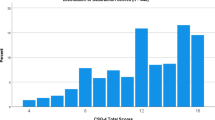Abstract
Although there are data on the psychometric properties of the Client Satisfaction Questionnaire (CSQ-8) in the United States Hispanic population, there are no data about the suitability of the questionnaire in Spanish-speaking populations in Spain. Trained and independent interviewers administered a Castilian Spanish translation of the CSQ-8 to 205 subjects (86.3% women, mean age 55.6 years) with subclinical depressive symptoms who participated in brief cognitive-behavioral group therapy interventions in Spain to treat subclinical depression. The internal consistency of the scale was satisfactory (α = .80). A single factor was identified that aggregated all eight items with high loadings in this global factor, which accounted for 43.5% of total variance. Differences in satisfaction were found based on the patients’ education level (p = .038) and post-treatment depressive symptoms (p = .021). There were no differences in level of satisfaction based on sex, age, marital status, social class, pre-treatment depressive symptoms or the number of sessions attended. The results indicate that the Castilian Spanish CSQ-8 has adequate psychometric properties and maintains those of the original questionnaire; therefore, it is suitable for use in Spain for assessment of satisfaction with services received.
Similar content being viewed by others
References
Attkisson, C. C. (2015). The Client Satisfaction Questionnaire (CSQ). Retrieved from http://www.csqscales.com/. Archived at http://www.webcitation.org/6hJGeESXS on 6 May 2016.
Attkisson, C. C., & Greenfield, T. K. (1994). The Client Satisfaction Questionnaire-8 and the Service Satisfaction Questionnaire-30. In M. E. Maruish (Ed.), The use of psychological testing for treatment planning and outcomes assessment (pp. 402–420). Hillsdale: Lawrence Erlbaum Associates.
Attkisson, C. C., & Greenfield, T. K. (2004). The UCSF Client Satisfaction Scales: I. The Client Satisfaction Questionnaire-8. In M. E. Maruish (Ed.), The use of psychological testing for treatment planning and outcomes assessment (Vol. 3, 3rd ed., pp. 799–811). Mahwah: Lawrence Erlbaum Associates.
Attkisson, C. C., & Zwick, R. (1982). The Client Satisfaction Questionnaire: Psychometric properties and correlations with service utilization and psychotherapy outcome. Evaluation and Program Planning, 5, 233–237. doi:10.1016/0149-7189(82)90074-X.
Barker, D. A., Shergill, S. S., Higginson, I., & Orrell, M. W. (1996). Patients’ views towards care received from psychiatrists. British Journal of Psychiatry, 168, 641–646. doi:10.1192/bjp.168.5.641.
Briggs, S. R., & Cheek, J. M. (1986). The role of factor analysis in the development and evaluation of personality scales. Journal of Personality, 54, 106–148. doi:10.1111/j.1467-6494.1986.tb00391.x.
Brislin, R. W., Lonner, W. J., & Thorndike, E. M. (1973). Cross-cultural research methods. New York: Wiley.
European Foundation for Quality Management. (2013). EFQM Excelence Model 2013. Brussels: EFQM.
First, M. B., Spitzer, R. L., Gibbon, M., & Williams, J. B. W. (1999). Entrevista Clínica Estructurada para los Trastornos del Eje I del DSM-IV- Versión Clínica (SCID-CV). [Structured Clinical Interview for DSM-IV Axis I Disorders, Clinician Version (SCID-CV)]. Barcelona: Masson (Original published in 1997).
Gotlieb, J. B., Grewal, D., & Brown, S. W. (1994). Consumer satisfaction and perceived quality: Complementary or divergent constructs? Journal of Applied Psychology, 79, 875–885. doi:10.1037/0021-9010.79.6.875.
Guillemin, F., Bombardier, C., & Beaton, D. (1993). Cross-cultural adaptation of health-related quality of life measures: Literature review and proposed guidelines. Journal of Clinical Epidemiology, 46, 1417–1432. doi:10.1016/0895-4356(93)90142-N.
Hall, J. A., & Dornan, M. C. (1990). Patient sociodemographic characteristics as predictors of satisfaction with medical care: A meta-analysis. Social Science and Medicine, 30, 811–818. doi:10.1016/0277-9536(90)90205-7.
Hall, J. A., Milburn, M. A., & Epstein, A. M. (1993). A causal model of health status and satisfaction with medical care. Medical Care, 31, 84–94. doi:10.1097/00005650-199301000-00007.
Larsen, D. L., Attkisson, C. C., Hargreaves, W. A., & Nguyen, T. D. (1979). Assessment of client/patient satisfaction: Development of a general scale. Evaluation and Program Planning, 2, 197–207. doi:10.1016/0149-7189(79)90094-6.
Marquis, M. S., Davies, A. R., & Ware, J. E. (1983). Patient satisfaction and change in medical care provider: A longitudinal study. Medical Care, 21, 821–829. doi:10.1097/00005650-198308000-00006.
Nguyen, T. D., Attkisson, C. C., & Stegner, B. L. (1983). Assessment of patient satisfaction: Development and refinement of a Service Evaluation Questionnaire. Evaluation and Program Planning, 6, 299–314. doi:10.1016/0149-7189(83)90010-1.
Pascoe, G. C., & Attkisson, C. C. (1983). The evaluation ranking scale: A new methodology for assessing satisfaction. Evaluation and Program Planning, 6, 335–347. doi:10.1016/0149-7189(83)90013-7.
Radloff, L. S. (1977). The CES-D Scale: A self-report depression scale for research in the general population. Applied Psychological Measurement, 1, 385–401. doi:10.1177/014662167700100306.
Roberts, R. E., & Attkisson, C. C. (1983). Assessing client satisfaction among Hispanics. Evaluation and Program Planning, 6, 401–413. doi:10.1016/0149-7189(83)90019-8.
Roberts, R. E., Attkisson, C. C., & Mendias, R. M. (1984). Assessing the Client Satisfaction Questionnaire in English and Spanish. Hispanic Journal of Behavioral Sciences, 6, 385–396. doi:10.1177/07399863840064004.
Rosenblatt, A., & Attkisson, C. C. (1993). Assesssing outcomes for sufferers of severe mental disorders: A conceptual framework and review. Evaluation and Program Planning, 16, 347–363. doi:10.1016/0149-7189(93)90049-E.
Rush, A. J., First, M. B., & Blacker, D. (2008). Handbook of psychiatric measures (2nd ed.). Washington, DC: American Psychiatric Publishing.
Säilä, T., Mattila, E., Kaila, M., Aalto, P., & Kaunonen, M. (2008). Measuring patient assessments of the quality of outpatient care: A systematic review. Journal of Evaluation in Clinical Practice, 14, 148–154. doi:10.1111/j.1365-2753.2007.00824.x.
Sitzia, J. (1999). How valid and reliable are patient satisfaction data? An analysis of 195 studies. International Journal of Quality in Health Care, 11, 319–328. doi:10.1093/intqhc/11.4.319.
Varela, J., Rial, A., & García, E. (2003). Presentation of a satisfaction scale with primary care services. Psicothema, 15, 656–661.
Vázquez, F.L., Blanco, V., & López, M. (2007). An adaptation of the Center for Epidemiologic Studies Depression Scale for use in non-psychiatric Spanish populations. Psychiatry Research, 149, 247-252. doi:10.1016/j.psychres.2006.03.004
Vázquez, F.L., Torres, A., & Otero, P. (2009). CSQ-8 Castilian (TMS.110). Retrieved from http://www.csqscales.com/
World Health Organization (2000). Evaluation of psychoactive substance use disorder treatment. Workbook series. Workbook 6: Client satisfaction evaluations. Retrieved from http://www.who.int/substance_abuse/publications/psychoactives/en/. Archived at http://www.webcitation.org/6hJHR7BsS on 6 May 2016.
Zemke, R. (1999). Service recovery: Turning oops into opportunity. In R. Zemke & J. A. Woods (Eds.), Best Practices in Customer Service (pp. 279–288). New York: AMA Publications.
Author information
Authors and Affiliations
Corresponding author
Ethics declarations
Conflict of Interest
The author declared no conflicts of interest.
Ethical Approval
All procedures performed in studies involving human participants were in accordance with the ethical standards of the institutional and/or national research committee and with the 1964 Helsinki declaration and its later amendments or comparable ethical standards.
Informed Consent
Informed consent was obtained from all individual participants included in the study.
Rights and permissions
About this article
Cite this article
Vázquez, F.L., Torres, Á., Otero, P. et al. Psychometric Properties of the Castilian Spanish Version of the Client Satisfaction Questionnaire (CSQ-8). Curr Psychol 38, 829–835 (2019). https://doi.org/10.1007/s12144-017-9659-8
Published:
Issue Date:
DOI: https://doi.org/10.1007/s12144-017-9659-8




